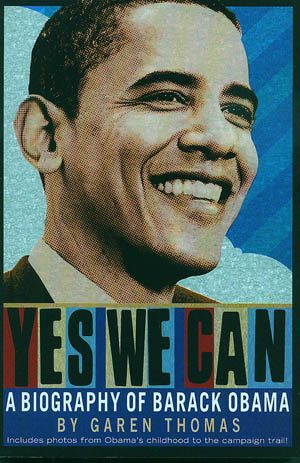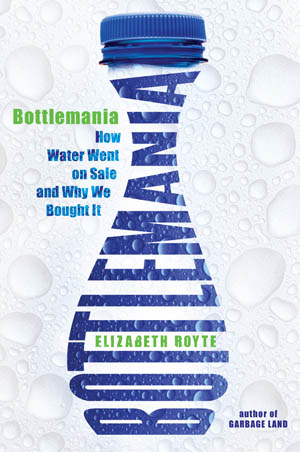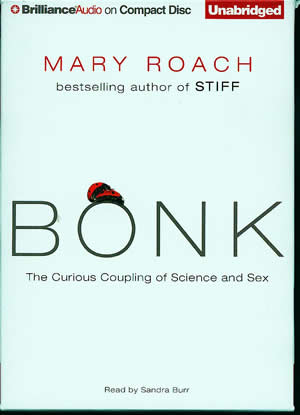Courtesy Bookworm Sez
Book review: Yes We Can: A biography of Barack Obama, by Garen Thomas
July 28, 2008 —
If you were old enough to vote this coming November, which candidate would you choose?
It’s not such a silly question. Kids know plenty about politics. You probably studied it in school, and why not? The person who gets into office will have a lot to say about your future.
You know about government, so why not learn about the candidates? Start by reading “Yes We Can: A Biography of Barack Obama” by Garen Thomas (c.2008, Feiwel and Friends; $6.99 / $7.99 Canada; 206 pages, includes index). In this new book, you’ll learn all about the soon-to-be-nominated Democratic candidate for President of the United States.
Barack Obama’s father was born and raised in Kenya, and came to America to attend college. Obama’s mother was born in Kansas but moved to Hawaii, where she, too, was attending school. Stanley Ann Dunham fell in love with Barack Hussein Obama, Sr., and they were married. Barack (sometimes called “Barry”) was born in 1961.
While young Obama never really knew his father (when Barry was two years old, Barack Sr. left his family and Ann divorced him shortly after), he knew he had family in Kenya. He also had a step-father from Indonesia, where Barry and his mother lived for a few years and where Obama’s half-sister was born. From Hawaii to Jakarta, back to Hawaii, to California, New York City, and Kenya, Barack Obama spent his childhood and his early adulthood traveling the world.
Way back when he first started school, Obama told his teachers that he wanted to be President some day. He always wanted to make a difference in the world and becoming President was one way to do it.
Once he was grown up, Obama still burned with a desire to make a difference. He took a job in Chicago, where he helped an apartment full of people to find jobs and get their homes fixed. Later, after graduation from Harvard Law School, Obama returned to Chicago and started his new career in politics.
Will he make history? Thomas says he already has: Barack Obama is the first African American who is a serious contender for the office of President.
Stay tuned…
With the internet and “instant news”, kids are pretty savvy about current events these days. They know this election will affect their future, too, which is why this book is important.
“Yes We Can” is an intelligent, teen-friendly book that not only gives kids an Obama overview, but also gives important insight into Obama’s background, his wrestlings with racial issues, and his drive for change.
What I liked best about this book is that author Garen Thomas lays bare the angst that young Obama had, his unusual male role models, and the fact that he wasn’t always a “good boy”. Obama was an angry young teen once and he overcame it, which may make him even more of a role model for kids today.
Although this book is meant for kids 9-and-up, I think that’s a reach. Teens and young adults, though, will love it – particularly if they’re current-events-minded. For them “Yes We Can” is a can-do.
![]() 1 Comment on "Book review: Yes We Can: A biography of Barack Obama, by Garen Thomas"
1 Comment on "Book review: Yes We Can: A biography of Barack Obama, by Garen Thomas"
Jerry — October 15, 2008
Obama is living his American Dream (doing what his mother and grandparents taught him), and that is making a difference in the world. I believe and hope (for America's sake) that we have another Mount Rushmore President.
Book review: "Bottlemania" by Elizabeth Royte
July 15, 2008 —
It is summer, and the thermometer reads somewhere in the 70s or Hades.
Pavement shimmies, shade is at a premium, and you can almost see the air. Every movement is an effort; even using your brain sends another river of sweat along the back of your neck.
And on top of it all, you’re thirsty. So what do you want to drink?
Read the new book “Bottlemania” by Elizabeth Royte (c.2008, Bloomsbury, $24.99, 248 pages, includes notes and index) and you’ll think twice before you reach in the fridge for a bottle of agua. Instead, you might rather tap into what comes through your kitchen faucet.
Or not.
When you grab a bottle of water from a store cooler, you expect liquid made of hydrogen and oxygen, right? Yes, says Royte, but not all water is the same. And yes, sometimes the two bucks you plunk down is money spent on pretty much the same stuff you can get from your bathroom sink.
But what does all that bottled water do to us? More importantly, what does it do to the environment? Is tap water really safer? To answer those questions isn’t easy.
In a small town in Vermont, Royte found a flood of controversy. A big corporation is piping up and trucking out hundreds of millions of gallons of water a year from New England aquifers, processing it into bottled water, and sending it to other parts of the country – for profit. Some residents and environmentalists are concerned about the effects of all this water removal on their lakes, wells, and flora nearby.
And, Royte says, townspeople may have reason to worry. Droughts are big news, and we’re seeing the environmental impacts of what goes into (and out of) our rivers and marshes, and what all that plastic (85 percent of it unrecycled) does to our land.
“We want convenience, cheap food… bigger houses, and faster gadgets,” says Royte. “Whether it’s building a second home or manufacturing meat, magazines, or mopeds, it all takes a toll on our water.”
Tap water, however, could be less-than-pristine. Worse, it could be a few short, quick steps from sewage, although officials deny that’s a problem.
So what can be done? Are those ubiquitous water bottles here to stay? Royte admits that the solution isn’t easy and it’s multi-layered. It starts with good old-fashioned conservation at home.
Occasionally a bit dry but dripping with timeliness, “Bottlemania” is a must-read for anyone who buys water, fills a re-useable bottle from the tap, or wonders what’s in that ice-cold glass of goodness at the restaurant.
Author Elizabeth Royte isn’t preachy; in fact, she seems to want to get to the bottom of the well on this controversy but obviously leans toward green. I appreciated the information she presents here, mostly because I think it will spur readers to debate personal habits and check the health of their own towns’ water supply.
Before you head to the store for more water or turn on the tap for a drink, read “Bottlemania”. It might make that sip of water seem like H2-uh-oh.
![]() Submit a comment on "Book review: "Bottlemania" by Elizabeth Royte"
Submit a comment on "Book review: "Bottlemania" by Elizabeth Royte"
c.2008, Brilliance Audio, read by Sandra Burr, $34.95, 8 CDs / appx 10 hours
Book review: "Bonk: The Curious Coupling of Science and Sex"
June 23, 2008 —
Remember the time you asked Mom or Dad about the “birds and the bees”?
Chances are, they hemmed and hawed. Got all red-faced. Mumbled something about men and women that sounded kind of icky. Pointed in another direction and said “Go ask your Mom/Dad.”
Or maybe you didn’t even go to them. Maybe you already knew “Everything You Ever Wanted to Know…” because you swiped a copy of that book from your best friend’s mother’s bedside table.
But how do we know what we know about sex? In the new audiobook “Bonk: The Curious Coupling of Science and Sex” by Mary Roach (c.2008, Brilliance Audio, read by Sandra Burr, $34.95, 8 CDs / appx 10 hours), you’ll see that the road to the birds and the bees wasn’t just paved with feathers and honey. Very odd inventions and eccentric minds were involved, too.
Ever since the first caveman saw deer dirty-dancing on the horizon, gazed over at his partner and thought “Hey...”, mankind has wondered about the waterbed waltz. Over the years, many erroneous beliefs about erogenous zones were held, including that the essence of life came from a man and that women had little to contribute to the system, and that impotence could be cured or caused by a witch. Even Leonardo da Vinci sketched some dubious theories about “Doing It.”
Pruriently or not but definitely quietly, early scientists spent lots of time watching the wild thang, ostensibly to gather information. Odd contraptions popped up in bedroom laboratories, including a mechanical phallus and see-through camera tubes that were invented in the name of learning. Famous researcher Alfred Kinsey interviewed 18,000 Americans about their sex lives, including gay men, prostitutes, heterosexual couples, and staff members. Masters and Johnson came along and disproved some of Kinsey’s theories with a little poking around of their own. Pigs, dogs, and hamsters were… uh, guinea pigs for gettin’ it on; scientists forgetting, obviously, that animals are a bit different than humans.
These days, laboratories are still fascinated by the featherbed fandango. Researchers have given us Viagra, MRI images of active couples, and implants so we can all have a ball in the bedroom. We can get jiggy artificially, alone, or with help from surgery. We know what the old in-and-out does for upbeat moods, all because a few intrepid souls got into someone’s pants.
Getting horizontal in the hammock this weekend? Then grab this audiobook and get ready to nail some laughs.
Author Mary Roach is one of the most subtly funny journalists you’ll ever have the pleasure of hearing; her asides are hilarious and the situations she puts herself (and her ever-patient husband) in are straight out of a for-grown-ups-only sitcom. Roach is a sneaky writer, in that her humor comes when you least expect it. I promise you, though, that you can expect to enjoy “Bonk”.
Although obviously not an audiobook you want to hear while driving the kids to swim class, this is a don’t-miss for the curious. If you’ve ever done the deed and wondered who studies that kind of thing, “Bonk” will make you positively vibrate with happiness.
Terri Schlichenmeyer reviewed books for the Vail Trail and now works with RealVail.com.
![]() Submit a comment on "Book review: "Bonk: The Curious Coupling of Science and Sex""
Submit a comment on "Book review: "Bonk: The Curious Coupling of Science and Sex""
| Read More Blog Entries | |||||
| |
|||||
| Blog entry 45 through 47 of 47 total entries | |||||
| Bloggers Profile and Information | |||||















